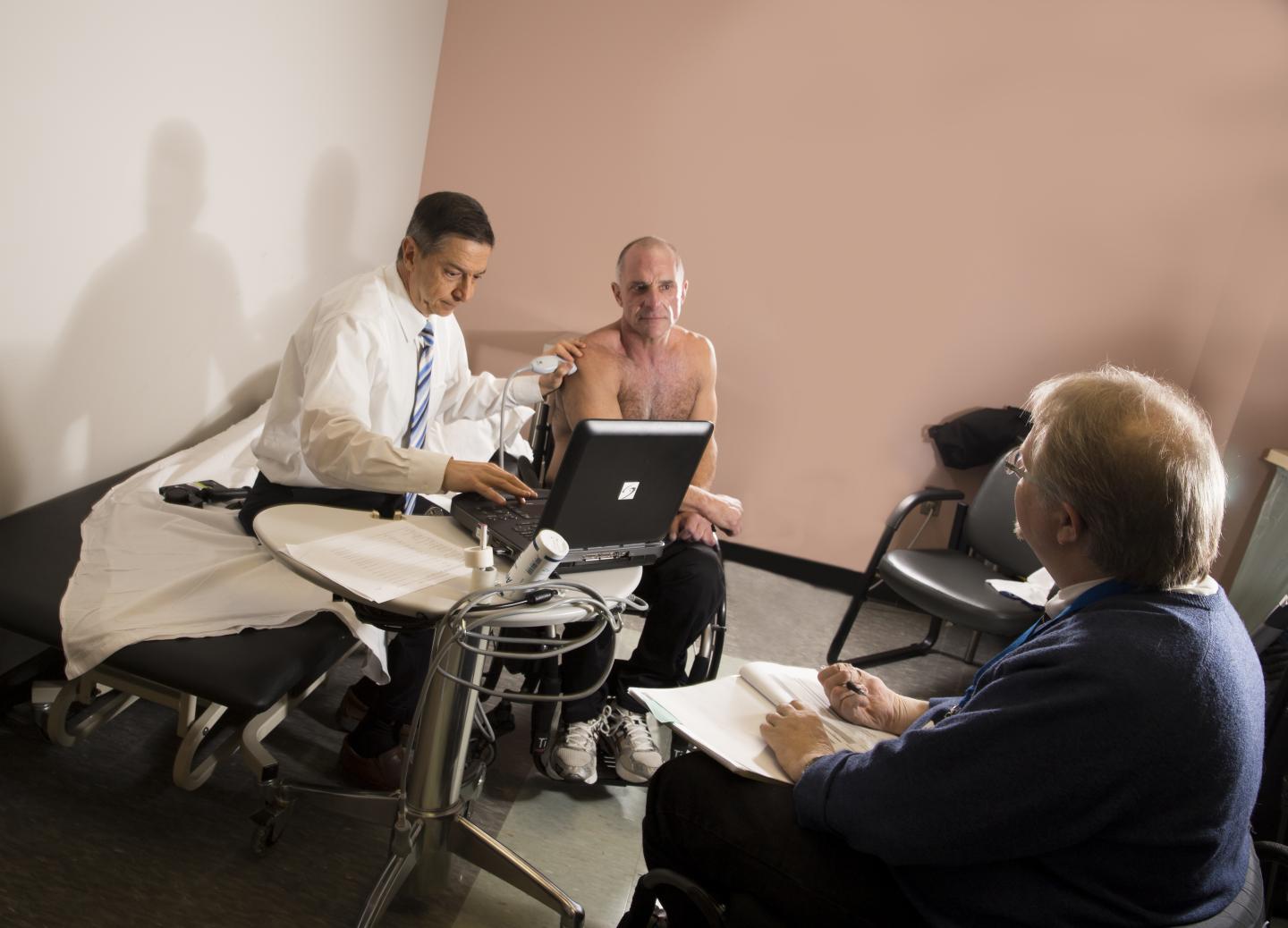The New Jersey Commission on Spinal Cord Research awarded a $549,000 grant to Trevor Dyson-Hudson, MD, of Kessler Foundation; the grant is one of three awarded to Foundation scientists for spinal cord injury research, totaling $1.74 million

Credit: Kessler Foundation
East Hanover, N.J., MAY 30, 2019. — Trevor Dyson-Hudson, MD, director of the Center for Spinal Cord Injury Research at Kessler Foundation, was awarded a $549,000 grant by the New Jersey Commission on Spinal Cord Research. Co-investigators are Gerard Malanga, MD, of the New Jersey Regenerative Institute and Kessler Institute for Rehabilitation, and Nathan Hogaboom, PhD, Derfner Foundation postdoctoral fellow at Kessler Foundation. They will conduct a randomized, controlled, parallel group trial of the effectiveness of a new minimally invasive intervention for disabling shoulder pain in wheelchair users with chronic spinal cord injury and overuse injuries – autologous micro-fragmented adipose tissue injection.
In April 2019, the Commission announced $3.4 million in grants to successful applicants from qualified research organizations in New Jersey. This grant is one of three individual research grants awarded to the Foundation, totaling $1.74 million.
For the study, 28 participants will be randomly assigned to receive an ultrasound-guided injection into the shoulder joint that contains either: 1) autologous, micro-fragmented adipose tissue; or 2) corticosteroid (triamcinolone acetonide). All participants will then undergo a standardized home exercise program, and periodic follow-up for 6 months after the injection, including physical examination and imaging studies.
Adipose tissue is a readily accessed source of mechanical, bioactive and bioavailable elements. The adipose used for the injection is obtained using the Lipogems® system. A person’s own fat is harvested and processed by the Lipogems system to yield autologous, micro-fragmented adipose tissue that is then injected into the shoulder joint under ultrasound guidance. These procedures are performed by Dr. Malanga, an expert in orthopedic and sports-related injuries.
The new intervention may expand treatment options for wheelchair users with intractable shoulder pain and limited range of motion. “If conservative treatments such as medications and physical therapy fail, then surgery is often the only remaining option,” said Dr. Dyson-Hudson. “Surgery, however, involves many months of recovery, which can have a significant impact on quality of life in persons who rely on their shoulders for everyday activities and independence,” he explained, “and their risk is especially high for poor outcomes.”
The new study is based on positive findings from a Kessler pilot study funded by the Derfner Foundation, which was the first application of this minimally invasive intervention in individuals with spinal cord injury. “The majority of the participants in our pilot study have reported significantly less pain and greater range of motion following a single injection,” Dr. Dyson-Hudson reported, “and this relief from pain and improved function was maintained even at the one-year follow-up visit.”
Corticosteroid injections offer relief from pain; however, relief from pain often only lasts a few months and repeated injections may cause damage to joint tissues. “With fat obtained using Lipogems, the injected fat tissue cushions damaged joint tissues and fills structural defects,” said Dr. Malanga, “and it delivers numerous cell types and growth factors that may foster tendon repair and regeneration. This new funding is an important step in our exploration of potential applications for regenerative approaches to disabling conditions, such as the rotator cuff injuries that are so prevalent among wheelchair users with spinal cord injury,” he said, in summary.
“The Commission clearly recognizes the importance of regenerative medicine to advances in rehabilitative care,” said Jay Lieberman, trustee of the Derfner Foundation. “This grant will accelerate the progress being made by the Kessler team toward finding solutions that reduce pain and disability among individuals with spinal cord injury.”
###
Funded by New Jersey Commission on Spinal Cord Research grants CSGR19IRG018
About the New Jersey Commission on Spinal Cord Injury Research
The New Jersey Commission on Spinal Cord Research, whose members are appointed by the Governor, was established on September 13, 1999, with the passage of the “Spinal Cord Research Act” by the New Jersey State Legislature. The Commission’s mission is to ensure that the people of New Jersey receive the utmost attention and benefit in our nation’s fight against spinal cord injury and disease through its promotion of research into the treatment and cure. The Commission was created to encourage and promote significant, original research projects in New Jersey through the funding of approved research projects at qualifying research institutions in the State. In addition, the Commission maintains, in conjunction with the New Jersey Department of Health, a central registry of all persons who sustain spinal cord injuries.
About Kessler Foundation
Kessler Foundation, a major nonprofit organization in the field of disability, is a global leader in rehabilitation research that seeks to improve cognition, mobility and long-term outcomes, including employment, for people with neurological disabilities caused by diseases and injuries of the brain and spinal cord. Kessler Foundation leads the nation in funding innovative programs that expand opportunities for employment for people with disabilities. For more information, visit KesslerFoundation.org.
For more information on Kessler Foundation’s research, visit KesslerFoundation.org.
Facebook |http://www.
Twitter | http://twitter.
Instagram | https:/
YouTube | http://www.
iTunes & SoundCloud | http://www.
Contacts:
Carolann Murphy, PA
Senior Staff Writer
973.324.8382
[email protected]
Rob Gerth
Director, Communications
973.323.3675
[email protected]
Media Contact
Carolann Murphy
[email protected]



